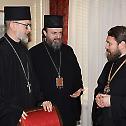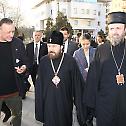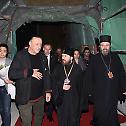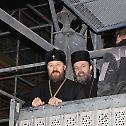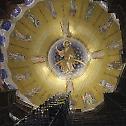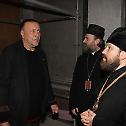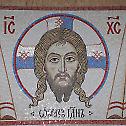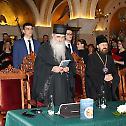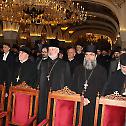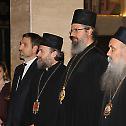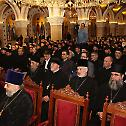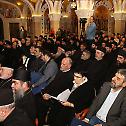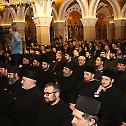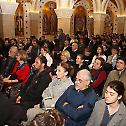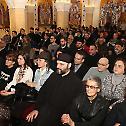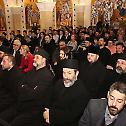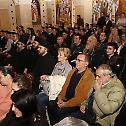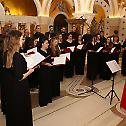Metropolitan Hilarion of Volkolamsk: “An Outline of Orthodox Faith”
 A presentation of the book “An Outline of Orthodox Faith” written by Metropolitan Hilarion of Volkolamsk (Alfeev) took place in the crypt of the Church of St. Sava, Belgrade, on February 17, 2020.
A presentation of the book “An Outline of Orthodox Faith” written by Metropolitan Hilarion of Volkolamsk (Alfeev) took place in the crypt of the Church of St. Sava, Belgrade, on February 17, 2020.
Contemporary Catechism, written on three hundred pages (with photographs) divided into 66 sections under the title “An Outline of Orthodox Faith” by Metropolitan Hilarion of Volkolamsk and in the edition of the Representation of Serbian Patriarchate in Moscow and the publishing house "Pravoslavac" from Sabac, was presented in the crypt of the Church of St. Sava in the Vracar district of Belgrade, on February 17, 2020. The book was translated from Russian by Bishop Anthonije (Pantelic) of Moravica, Vicar Bishop of the Serbian Patriarch.
On the Catechism of Metropolitan Volokolam Dr. Ilarion, chairman of the Moscow Patriarchate’s Department for External Church Relations, who, in a simple way and in a modern language, builds up evangelical and patristic foundation of the Orthodox faith, spoke: His Grace Bishop Irinej (Bulovic) and lecturer of the Faculty of Orthodox Theology Dr. Zoran Devrnja as well as the author of the book. It was a unique presentation of the book because of its brilliant theological thoughts.
The book was written by this distinguished guest and a sincere friend of Serbian people, Metropolitan Hilarion, who was on his fraternal visit to His Holiness Serbian Patriarch Irinej and the Serbian Orthodox Church.
“His Eminence Metropolitan Hilarion is not only a guest, but also a host, since he is Dr. honoris causa of the largest and most representative institution of university education and science, the University of Belgrade, but at the suggestion of the Professors’ Collegium of the Faculty of Orthodox Theology as the highest educational institution of our local Church. In that sense, whenever you visit Serbia and Belgrade, beloved Bishop, and when you come to our Faculty, to our University and to our Church, you come to your own people, to your own home, where you completely belong with your extensive and high-ranking and most valued theological and scientific works," said lecturer of the Faculty of Orthodox Theology Dr. Zoran Devrnja, adding:
“The book ‘An Outline of Orthodox Faith’ is a successful attempt of the Metropolitan to expose his far more extensive and meaningful study in the field of dogmatic theology in a form of concise explinations, topics, and questions that arise in the daily spiritual experience of the faithful believers, to make it accessible and terminologically acceptable and understandable to any modern, ordinary believer, a member of the Church in Russia as well as in Serbia or any modern country and modern society today."
The book is a kind of step-by-step manual intended for anyone interested in learning the fundamental truths of the Orthodox faith and the ways of living by that faith, following the logic of revelational chronology.
His Grace Irinej , Bishop of Backa, delivered an inspirational laudatio about the guest himself, Metropolitan Hilarion, telling that in spite of all his huge obligations, he had processed, presented, studied and published his theological topics in a marvelous manner, but in a way which is the only possible and salvific for us today, told His Grace Irinej about the book “An Outline of Orthodox Faith”.
"We must be faithful to the Holy Tradition if we want salvation to ourselves and to the world, but that doesn’t mean giving up theological research and knowledge," said the His Grace Bishop and added: "On the other hand, we face a temptation of the so-called scientific theology. This is a new, hybrid fruit, unfortunately present here among us in this city, unfortunately also at the Faculty of Theology, where it is considered that theology is an intellectual, scientific and research activity, that it is an exclusive responsibility of the University, not of the Church. It is forgotten that there is no theology without and outside the Church, and not only that – there is no theology without personal and catholicit experience…”
"We now have a problem that many people yearn for Christ, yearn for God, yearn for the Truth of God, feel that their life is empty without God, but they do not know how to meet the Living God. For this to happen, an educational word of the Church is necessary, the confirmation of the Gospel is necessary, because even at the time when the Lord Christ was on earth, it was not enough that He, as a Theandric personality, testified about Himself and at the same time the Heavinly Father testified about Him, as well as The Holy Spirit and the prophets of the Old Testament, but it was necessary for His disciples, the Apostles, to witness Him. This is necessary today as well. And today, no matter how weak or little our faith may be, we must be the apostles of Christ in small," said His Grace, Bishop Irinej of Backa.
For the Catechism of Metropolitan Hilarion can be said that it is a conscious dialogue with an educated contemporary young man who is consciously and unconsciously thirsty and hungry for God, and therefore the title of the book “An Outline of Orthodox Faith” offers the answer to the question “Who Orthodox Christians Believe in”.
“The Catechism of Metropolitan Hilarion, concise and conceivable, yet authentic, not only will it be accessible to the most contemporary believer, but it will be much more valuable to our educated, but in Christianity still immature young man,” said His Grace Bishop Dr. Irinej (Bulovic).
THE SPEECH OF HIS EMINENCE METROPOLITAN HILARION
Your Graces, reverend Fathers, dear brothers and sisters. First of all, I would like to express my sincere joy for being blessed by the Patriarch of Moscow and all Russia Kyril and at the invitation of His Holiness the Patriarch of Serbia Irinej to have this opportunity to visit my beloved Serbian land again.
Before starting with my evaluation of this book, I had the opportunity to look very closely at the work in progress in the upper zone of the Church of St. Sava, where our outstanding masters, mosaicists from Russia, strive to decorate the dome of the Church. I had the opportunity to climb all the way up to the top by a construction elevator, from where I saw a dome, the space under the dome, a pandatives. More than once in my life, I have had the opportunity to participate in church painting and restoration, and I have always tried to take the opportunity to use the elevator all the way up, because when the scaffolding is removed, what can be seen above is only from below. This way you won’t be able to see with what care the mosaicists placed each pebble so that it corresponds in size and color to its neighboring pebbles.
I remember now how we started this project, how difficult it was at first to find the masters who would accomplish this grandiose project and provide the means to realize it. And to be honest, when we started out, I thought this project would last for 30 years. But now I have seen that the mosaic works largely go towards the end. And I was very pleased to see that this magnificent church will be completed and spiritually decorated not only outside but also inside very soon. And it will be not only a remarkable monument of Christian construction and architecture, but also of Christian art. Built for the Glory of God, it will speak to everyone for the Glory of God. And I am very happy that the Russian Church and the Russian state have been contributing to the decoration of this magnificent church. And I am happy to have the honor of being involved in this project.
Today, the Serbian Orthodox Church is going through a period of great temptations. And these temptations affect the Serbian Orthodox Church in the neighboring country, Montenegro. What happened in Ukraine a year ago it is repeated in Montenegro now. In Ukraine, the ex- president decided to found a new church. He imagined that he could personally found the church and that the foundation of a new church, independent of the Russian Orthodox Church, would help him in the electoral campaign. However, he suffered a fierce defeat in his electoral race. But he managed to make much damage to the Church through his activities. Today, something similar is happening in Montenegro, where the authorities have adopted a discriminatory law that allows churches (places of worship) to be taken away from the canonical Serbian Church and given to anyone. The authorities have turned against their people, and the people have gone out to the streets. And we see in Montenegro thousands and tens of thousands of people in the streets in cross-precessions supporting their Church.
I would like to assure you all that in this holy noble struggle the Russian Orthodox Church will be with the Serbian Orthodox Church. And I would like to wish all of you to end as soon as possible this difficult burst of temptations that affect the Orthodox Church in different countries. First, these temptations began in the canonical territory of the Russian Orthodox Church, and now they have passed into the canonical territory of the Serbian Orthodox Church. Authorities try to govern the Church and found a Church at their discretion. But the Church was found by the Lord Himself. And the guardian of the Church is the Church people. As a matter of fact, these people have gone out into the streets today.
I won't talk much about this book since Prof. Zoran Devrnja presented its contents in great detail, and I am very grateful to him, and my dear fellow brother Bishop Irinej explained what kind of readers this book might be interesting to.
I would like to thank to Bishop Antony, a representative of the Serbian Orthodox Church at the Moscow Patriarchate, who initiated the publication of this book in Serbian and translated it. The book is written for a wide range of readers, not just for experts in the field of theology.
I have written several voluminous books aimed specifically for theologians. But whenever I start writing a book, I always try to answer some questions first and foremost to myself. And I never write down on paper those thoughts that I have not fully clarified. I try to talk about the most complex theological questions as simply as possible. In this book, I touch on the basic theological truths which Orthodox theology is based on. When you talk about dogmatics to a common man, he thinks it is something rigid, frozen, something far away from him. And I try to show in my book that dogmas are what the Church is based on. Much like the dome in this church is based on these pillars. And the St. Sava Memorial Church rests on a foundation buried deep in the ground. Likewise, the Church rests on dogmas. They may not be overly visible, but if that dogmatic foundation is lost, then the whole building collapses. And a man who does not fully understand the dogmas, can hardly understand why the Church exists and what it stands for.
Our Orthodox worship is fully filled with dogmatic truths. When we in church preside over the Holy Liturgy or Matins or Vespers, we should know that the liturgical texts are full of dogmatic truths. And if we do not recognize and love the dogmas, then it is very difficult to understand and love Orthodox worship. But as I have mentioned in my book, dogmas themselves are not some kind of inventions of theologians. Dogmas were not born in the minds of some professors sitting at a desk with a pen or pencil in their hand, or at computers - dogmas were what had initially been laid at the very foundation and at the very heart of the Church. The task of the theologians of all epochs has been to formulate and convey these dogmas to others in a language accessible to them. And very often the Church Fathers formulated dogmatic truths in response to the heresies that had emerged. To give just one example, and there are many. There was much discussion in the 4th and 5th centuries about how the divine and human nature were united in the Lord Jesus Christ. And then one of the 4th century theologians named Apollinaris came up with the following theory: that Jesus Christ had a human body and that his soul and mind were divine. And, apparently, what was wrong with such an explanation?
But the sharp theological mind of St. Gregory the Theologian recognized a dangerous delusion in this. He said: behold, if the Lord Jesus Christ did not have the human mind and the human soul, how then the salvation of man came. He, too, formulated the principle that came into all-Orthodox Christology and the entire Orthodox teaching of salvation: that which is not taken, that is not healed. If the Lord Jesus Christ had taken over from us the human body, but his soul, spirit, and mind remained divine, then only our body would have been saved. No, says St. Gregory the Theologian, he took over all human nature, both spirit and soul and body. And why is this important to us? Because he took upon himself our human body, our mind and our soul. This dogma is directly related to our personal salvation and our personal destiny in eternity.
I have given just one example, and there are many. And it is not so easy to explain everything to the modern man, because he lives on other ideas and thinks about other categories. Therefore, it is the task of the modern theologian to convey the sacred ancient truths formulated in the ancient language to modern man. And it needs to be conveyed so that the modern man not only understands it, but that it permeates him and that he loves it.
I am deeply convinced that Orthodox theology should be not only true, but also inspired. And through this book I would like to convey to the reader at least a part of that inspiration that I felt not only when I was writing the book, but also when this dogmatic theology was being introduced to me through the works of the Church Fathers. I hope that because of this, not only in Russia but also in Serbia, it will find a way to their readers.
I would like to wish all of you God's help in your efforts and your ministry. May the Lord save Serbia, Serbian people, and the Serbian Orthodox Church! And know that Russia and the Russian Church are with you!
Written by Zorica Zec
Translated into English by Sanja Simic de Graaf, Professor, Loznica

